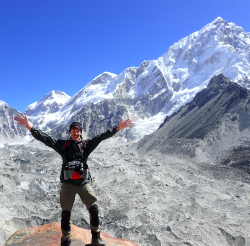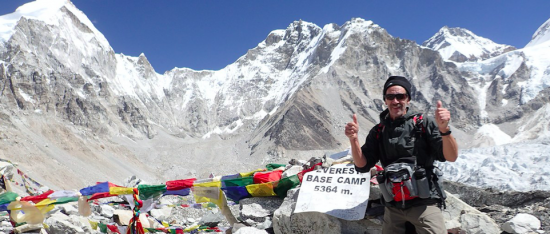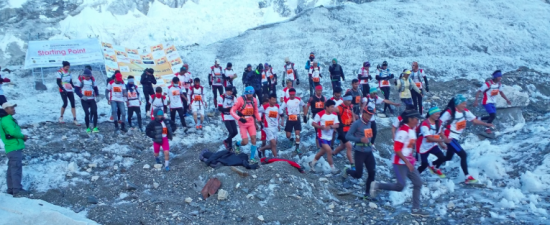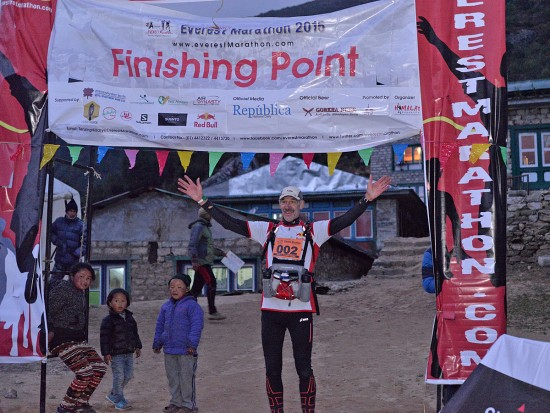
The Mount Everest Marathon is held every year on May 29, the day that Edmund Hillary and his Sherpa Tenzing Norgay reached the summit of the highest mountain in the world in 1953. The marathon consists of two parts: a trek (running) and the marathon over 42 kilometers. From Kathmandu (Nepal) you fly to Lukla (2860m) to climb from there to Namche Bazaar (3460m). From Namche Bazaar you walk in 12 days, the route of the Marathon, to the base camp of the Everest. Highest point Kala Pattar 5643m. During the trek you have ample time to explore the trail, get used to the altitude and enjoy the amazing surroundings. In the meantime there are "relaxation or acclimatization days". Eventually you start on the Khumba glacier for the marathon race.
After various ultra-marathons (Marathon des Sables in Morocco, Atacama Crossing, North Pole etc.) where circumstances such as cold and heat were involved, I thought it would be interesting to see how my body would react at extreme heights. During the Atacama crossing in Chile I already had a taste. The desert is on a plateau and the height during the marathon varies from 2500 to 3500 meters. The combination of altitude, drought, heat, cold (!) And endless (salt) plains makes it one of the toughest marathons in the world. During such a walk I always have something like "what did I start?"
Cold across the finish line, I look forward to the next challenge. In this case the Everest marathon.
I'm in a hurry. I am now 64 years old and notice that the number of injuries is increasing. I have made the necessary adjustments, such as special insoles, compression socks and last but not least, adjusted my speed. 30 years ago I walked 2.38 on the marathon, now I am approaching 4 o'clock. Everything because of the holy purpose; keep running for as long as possible.
“After a few weeks I clearly notice an improvement in the condition. The natural EPA is starting to work "
In ultra-marathons, preparation is one of the most important parts. I start by collecting information on the internet, then I track down people who have run the marathon and interview them. I also compile equipment lists and have a chat with the doctor at the Sports Medical Advice Centre. There, I am also subjected to a sports test. Slowly but surely, I start to realise that altitude sickness can become a problem. Googling the word altitude sickness (AMS) you automatically come across the website of 'Altitude Dream' altitude training. For me something totally new. The explanation of how an altitude tent works contains a certain logic that I can agree with, and in mid-March 2015, thanks to their rental service, I start my session of spending 4 weeks overnight "at high altitude" in an altitude tent. It goes well. I keep a certain schedule and carry out the sessions with the altitude mask. I force myself to drink a lot of water, something I normally do too little of. This leads to an extra number of sanitary stops during the night. The problem is then getting back to sleep. After a few weeks, I clearly notice an improvement in my condition. The natural EPO starts to work.
April 2015
I'm ready for it. And again it goes wrong .. On April 25, Nepal is hit by a severe earthquake with a magnitude of 7.8 on the Richter scale. More than 7,000 people die. Tens of thousands injured. The organization of the marathon insists that the trip continues as normal (?!). The route would be easily accessible and the buildings and bridges intact. That changes on May 12 when a second earthquake (7.4) follows in the Everest region.
For me the third (!) Time that fate strikes. In 2008 I was in Chengdu (China) when a huge earthquake occurred (7.8 - 70,000 deaths). In February 2010, I was at the start of the Atacama Crossing in Chile when Richter made himself heard again (8.8) and now Nepal. So I change my mind twice before registering for the 100 km of Winschoten (Groningen).
September 2015
The marathon will be postponed until September 19, 2015. A bridging time. Again I spend 4 weeks in August in a height tent of Altitude Dream. My wife is slowly getting tired of it .. Eventually the time has come and I will fly to Kathmandu on September 19. The capital of Nepal is at 1500 meters and so I can already acclimatize. Two days later is the briefing and the press conference. Of the initial 100 participants in April, 50 are now left. Seventeen international. Very confronting: I turn out to be the oldest participant and am the center of attention. Here and there you see the doubt whether "that old man" is capable. They'll find out soon.
After waiting two days at Kathmandu airport, the weather conditions in Lukla were bad, it was decided to rent a helicopter. Lukla is unreachable for regular flights. I wonder what the difference is if we fly there by helicopter. In good spirits we board the pick-up that will take us to the aircraft. That turns out to be much smaller than we had imagined. Like sardines in a can. With seven people where there is room for 5. Doesn't matter. Glad we left that musty departure hall.
The helicopter takes off. The sun is shining, nothing wrong. When we reach the first peaks it starts to get involved. As we dive deeper into the mountains, the beating rain starts to become annoying. After half an hour we are in the middle of heavy weather. Lightning flashes, torrential rain, thunder. In my humble opinion, the pilot does not see anything in mind. If you know that pilots fly here purely by sight, that is somewhat disturbing. He desperately tries to find his way under the windscreen wiper. The heli jumps through the air like a table tennis ball. A toy of the elements.
I look at my companions and notice some unrest. The pilot nibbles nervously in his microphone and finally shouts at us that it is impossible to fly to Lukla. He will place his device on a lawn near Paknepani.
That is a completely new perspective, but then again, we also came for the adventure! Downstairs we see a few sheds and a tent. There are some locals who are surprised and looking upwards. Not only our helicopter appears to be making an "emergency landing". Around us it is teeming with lost helicopters and before we know it we are standing on the lawn together with 2 other helicopters.
For us, the trek to Everest Base Camp starts here. Because we are two days late, the ascent per day is often more than 400 metres. During the first few days, I notice a slight headache that is easily controlled with an ordinary aspirin. Some of the other participants are less fortunate and are already on acetazolamide. It continues to rain for three days. Then, at Dingboche, we climb above 4000 metres and the sun actually shines. The headache also disappears like snow in the sun, no altitude sickness at all. All those weeks in the altitude tent were not for nothing. Besides, I always walk in the front while the rest of the participants have problems keeping up with the pace.
Occasionally there is a relax or acclimatization day. Whoever thinks you can sleep late will be disappointed. Usually a climbing trip is undertaken, such as on October 2, where we climb the Kala Patthar, the highest point of our trip (5600 meters).
Eventually we reach the base camp of the Everest (5400 meters). Totally different than what I had imagined. The earthquake has kept a big hold here and we have to make a new path across the Khumba Glacier to reach the camp. Everest cannot be seen from the base camp. The Khumba Icefall is a life-threatening zone between the base camp and camp 1. The base camp is extinct. After the earthquake in April that killed 19 climbers, there was no one left except for a few. We spend the night in a few small tents on the glacier. Below us the continuous sound of running water. The constant roar of stone and snow avalanches around us. I don't sleep well that first night. Our tent is also under a huge rock that lies on an ice plateau. A little too much thaw or a small earthquake and we'll stay in base camp forever.
The second night is better. I decide to banish all wrong thoughts and I sleep like a baby.
It is 3.00 a.m. on Monday, 5 October. Frosty cold -25C. In the pitch-dark we prepare for what we came for, the marathon. Ultimately, there appear to be 50 participants. Nepalese, Chinese and Indians have been added. At 7 a.m. the whistle sounds and the first runners shoot across the glacier to Gorakshep. It is an area that you do not wish for your worst enemy. The enormous ice peaks ensure traffic jams. We jump over small waterways. There is a layer of frost on the stones and large pieces of bluish ice in between. Participants are regularly a few meters lower and need to be helped by others. After more than an hour and a half and 4.9 km we reach the first checkpoint. Despite the difficult course I have no problems. Speed is not important, but finishes. The trail goes continuously from mountain to mountain. It is popularly called "Nepali flat". That is because the route goes from east to west while the rivers and valleys run from north to south. After completing the marathon, we will have climbed more kilometers than the Everest is high (8848m).
My fame or should I say my age has now rushed ahead. In every village I am welcomed as a hero. My starting number is known and my age is the talk of the day. They are probably expecting a man with a long beard and crooked legs (the latter is true). Old males, who are probably younger than me, are encouraging on the back, I am offered a stool and mother the woman comes to eat with a dish. That goes well until I realize that it takes too much time. Before the third village I therefore switch on and walk through at top speed (!?). Leaving the residents loudly applauding and accompanied by a number of dogs that are almost hanging in my calves.
In the end I am on my way for more than 10 hours to bridge the classic distance. More than double, from the winner, a Nepalese army officer who arrived in 4.01 (!). When I enter Namche Bazaar, it is already dusk. Yet I am very satisfied. No problem on the way and enough energy left to get through the last two days (26km). The height tent has raised its money twice and for all!
Rob Plijnaar
For an extensive photo reportage of the Everest Marathon, click on my website



